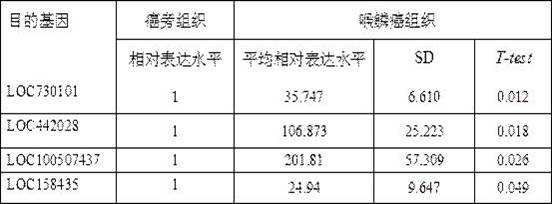Application of LOC158435 as biomarker for diagnosing and treating laryngeal squamous cell carcinoma
A laryngeal squamous cell carcinoma and drug technology, applied in the field of biomedicine, can solve the problems of difficulty in early diagnosis of laryngeal cancer and high postoperative recurrence rate
- Summary
- Abstract
- Description
- Claims
- Application Information
AI Technical Summary
Problems solved by technology
Method used
Image
Examples
Embodiment 1
[0048] Example 1 Molecular verification of differential expression
[0049] 1. Research object
[0050] The cancer tissues and corresponding paracancerous tissues of 45 patients with laryngeal squamous cell carcinoma were collected. Inclusion and exclusion criteria: ①Patients have no primary tumor other than the primary tumor, and the primary tumor has not metastasized; ②No history of cardiovascular and cerebrovascular diseases such as diabetes and hypertension; ③No infectious diseases such as hepatitis, syphilis, tuberculosis, and HIV Medical history; ④ no family history of genetic diseases; ⑤ no radiotherapy, chemotherapy and biological therapy before operation.
[0051] Sampling precautions: When cutting tumor specimens, pay attention to cutting non-necrotic tumor tissue in the central area of the tumor. When cutting normal adjacent tissues, try to stay away from the tumor as far as possible, and be more than 1.5cm away from the edge of the tumor. Try to cut mucosal epit...
Embodiment 2
[0103] Example 2 LncRNA silencing
[0104] 1. Cell culture
[0105] The human laryngeal squamous carcinoma cell line Hep2 was incubated in RPMI1640 medium containing 10% fetal bovine serum and 1% P / S at 37°C and 5% CO 2 , cultured in an incubator with a relative humidity of 90%. The medium was changed once every 2-3 days, and the cells grew well and showed a monolayer adherent growth. Use 0.25% EDTA-containing trypsin for routine digestion and passaging.
[0106] 2. Transfection
[0107] 1) Treatment of cells before transfection
[0108] The day before transfection, 3~5×10 5 Cells / well were cultured in antibiotic-free medium for one day, and the cell density was 30-50% at the time of transfection, and replaced with serum-free medium before transfection.
[0109] 2) Design of siRNA
[0110] Two groups were set up in the experiment: negative control group (siNC, transfected with negative control siRNA), and siLncRNA silencing group (transfected with siRNA against LncRNA)....
Embodiment 3
[0131] Example 3 The effect of LncRNA expression on the proliferation of laryngeal squamous cell carcinoma cells
[0132] WST-1 method was used to detect the effect of lncRNA expression on the proliferation of laryngeal squamous cell carcinoma cells.
[0133] The next day after cell transfection, adjust the cell density to 1×10 2 / μl, seeded in a 96-well plate (100 μl / well), and each group set up three replicate wells. 37°C, 5% CO 2 After culturing for 72 hours, add 10 μl of WST-1 and incubate for 2 hours, then detect the optical density (D) value of the cells at a wavelength of 450 nm with a microplate reader.
[0134] The result is as figure 1 As shown, the difference between the groups was statistically significant (* P <0.05). It shows that the expression of LOC730101, LOC442028, LOC100507437 and LOC158435 can inhibit the proliferation of laryngeal squamous cell carcinoma cells.
PUM
 Login to View More
Login to View More Abstract
Description
Claims
Application Information
 Login to View More
Login to View More - R&D
- Intellectual Property
- Life Sciences
- Materials
- Tech Scout
- Unparalleled Data Quality
- Higher Quality Content
- 60% Fewer Hallucinations
Browse by: Latest US Patents, China's latest patents, Technical Efficacy Thesaurus, Application Domain, Technology Topic, Popular Technical Reports.
© 2025 PatSnap. All rights reserved.Legal|Privacy policy|Modern Slavery Act Transparency Statement|Sitemap|About US| Contact US: help@patsnap.com



